2019
Research Collaborations and Partnerships
The 2019 research year is well underway, with nearly four hundred research projects planned for implementation at the Carrington Research Extension Center. These projects are designed to address issues that affect our crop and livestock producers and the natural resource base that supports our diverse agriculture in North Dakota. At the CREC, research program leaders in the disciplines of agronomy, soils, plant pathology, precision ag, organic ag, animal science, and fruit production, initiate research projects independently and in collaboration with colleagues at the Main Station in Fargo and other NDSU Research Extension Centers.
Ultimately, the research projects at the CREC represent many different collaborations and partnerships between the public and private sectors working together to meet the diverse needs of farmers and ranchers. Many who follow the programs at the CREC are likely familiar with the collaborations we have with our NDSU colleagues. We also partner with the USDA, other Federal agencies and certainly state agencies such as the Agriculture Department, Department of Health, Water Commission, Soil Conservation Districts and others. Our collaborations with the different crop commodity organizations are very important. Their financial support allows us to work to address many of their priority needs.
The research collaborations that are often under the radar and especially significant in both number and impact are those collaborations we have with private sector businesses, our broad agri-industry. NDSU agricultural research is a very important part of the process that the private sector utilizes to bring new technologies into the marketplace. Agriculture is a complex industry, there are hundreds of companies that are involved with providing services and products to our farmers and ranchers. We have a continuous evolution of new technologies that are being developed, evaluated, refined and ultimately introduced to our producers because of their merits or discarded because of their fallacies. Typically, dozens of private sector businesses collaborate with researchers at each REC annually. These businesses range from the major multi-national companies to new start-up enterprises. These collaborations allow us to greatly leverage our state resources to expand the capacity for agricultural research on behalf of the state’s major industry. Our private sector collaborators look to the RECs to evaluate their product in our unique environments. Our research is used to refine product-use strategy, provide comparison to competitor alternatives, develop data for product registrations and ultimately aid in determining whether the product is viable. Finally, the resulting information is highly sought after as the primary source of non-biased, research-based information by the farmers and ranchers as they decide whether to incorporate that product or technology into their operation.
One might question how our researchers determine what issue, challenge or problem they will design a research project to address given the very diverse agriculture we have in North Dakota and the many potential trials that are brought to their attention. The ongoing communications we have throughout the year with our producers, commodity organizations and industry ultimately formulate a perspective of which needs are the priority. We also have a formal means for our farmers and ranchers to provide input and direction for our research. This is achieved through the information we receive from our CREC Advisory Board. Our advisory board is comprised of 16 board members who represent counties within this region, the Garrison Diversion Conservancy District and the Carrington community. This advisory board meets twice a year with the next meeting scheduled for June 11. During this meeting board members each have the opportunity to share their ideas as to what are the most pressing challenges they face in their own operation and those of neighbors across the county or area they represent. The CREC Advisory Board plays an important role in guiding the direction of our research programs for not only their benefit, but for the benefit of agriculture across the state.
Blaine G. Schatz
Blaine.Schatz@ndsu.edu
Director and Agronomist
Memorial Day 2019
I stopped to visit with one of my neighbors last week. Topics of our discussion ranged from baseball to graduation to upcoming family weddings to ‘when is the sun going to shine?’. This past weekend was busy, no doubt. But something else came up in a few conversations last week too. This neighbor takes care of the rural cemetery just down the road from us. It’s a bit of a family affair with someone weed eating while another mows and tends the flowers. In another conversation, one of my colleagues told me he tended to another local cemetery for 19 years, mowing one or three times a month depending on rainfall and making sure stones were cleaned off and visible afterward. So how much does a job like this pay? Those who do it would say it pays in pride, honor and a sense of completed responsibility. Several of us will be heading to the lake, in the field or working livestock to send to pasture. But if you get a chance to attend one of your small-town Memorial Day celebrations in the local cemetery let’s not only remember our veterans who we honor with Decoration Day, but also those who work quietly behind the scenes.
Information about the history of Memorial Day can be found here: http://www.usmemorialday.org/.
Mary Keena
Mary.Keena@ndsu.edu
Extension Specialist / Livestock Environmental Management
Thinning Apples
This cooler weather gives me a break from finishing apple pruning so that I can tell you about a future activity: thinning apple fruit. If you thin the young fruit on your apple tree, you will increase the size and sweetness of the crop and reduce stress on your tree so that it might bear fruit every year.
Early June is a perfect time to do this when the fruits are dime- to nickel-sized. Just use your fingers. Gently, but firmly, tip the little apples to the side and they should crack off. Drop them on the ground. If there’s no disease, you can just let them dry up in the grass. Be gentle enough so that you don’t break off the whole fruiting spur.
Thin to 1 apple per cluster and 1 fruit every 4-6 inches. You might have to remove a whole cluster to achieve this. Keep the biggest apple in the cluster (the king fruit). If you have a choice, chose to keep the apple nearest the main branches. The farther out they are toward the tips, the more they will bend or break the branches as they get grow.
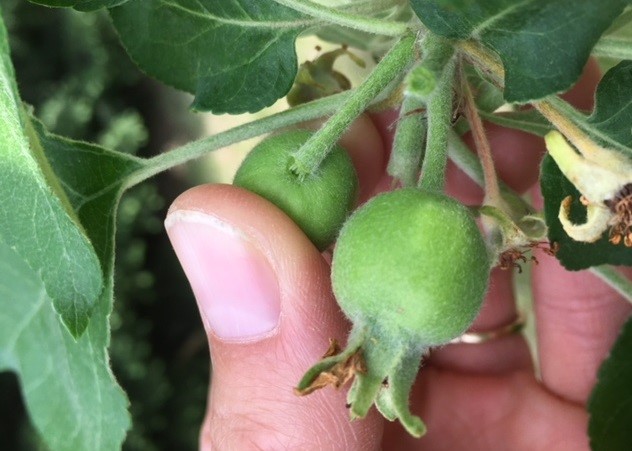
Gently, but firmly, tip the little apples to the side and they should crack off.
After you thin the apples, wait about 2 weeks and thin again. This time the apples will be larger and you will see all the clusters you missed or perhaps you would like to widen the space between fruits. Note: If you wait to do the first thinning until the fruit is bigger, you will not influence the final crop or the next year’s crop near as much. It really needs to be done at the dime- to nickel-size.
Remember that pruning is your first line of control for the number of apples on the tree.
Below is an example of a Zestar! apple tree that was not thinned or pruned. It had both ripe apples falling off and still-green apples at the same time. The photo was on the north, shady side of the tree where no direct sunlight could penetrate. The fruit I am holding is from CREC trees, which I picked in 2 sessions about 5 days apart. Our harvest was complete the day before this comparison photo was taken.
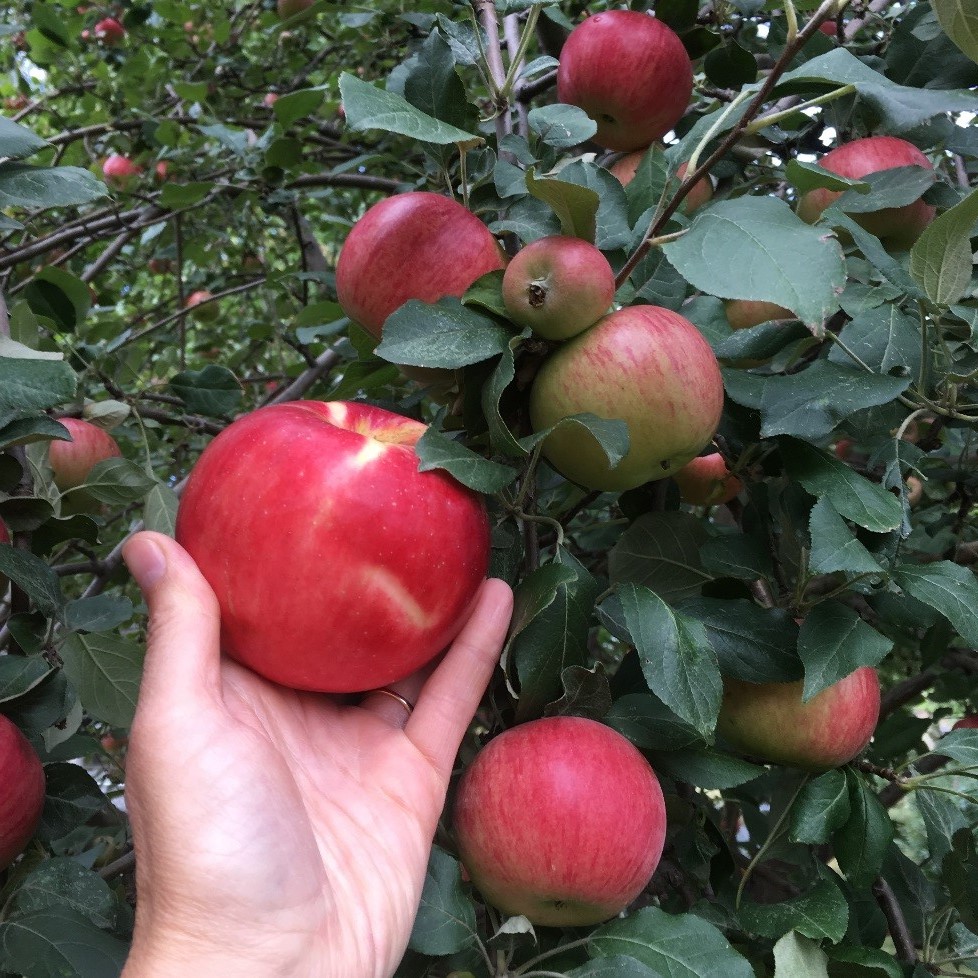
Kathy Wiederholt
Fruit Project Manager
Kathy.Wiederholt@ndsu.edu
www.facebook.com/crecfruit
Consign Your Steers
North Dakota State University's Carrington Research Extension Center (CREC) is partnering with the North Dakota Angus Association to sponsor the North Dakota Angus University feed-out. This is the eighth year of the program.
Producers can consign steers to the feed‐out program by contacting the CREC. Consigned steers should be at least 50 percent Angus genetics and weigh between 800 and 900 pounds at the time of delivery. Consigned cattle should be delivered to the CREC feedlot the first full week of June (June 3-7).
Producers who consign cattle pay the feeding costs based on the average cost of gain, plus veterinary costs and a modest yardage charge. The CREC will carry the feed, veterinary and yardage costs until the cattle are marketed. After the cattle are marketed, costs and all applicable fees are deducted from the sale price without an interest charge.
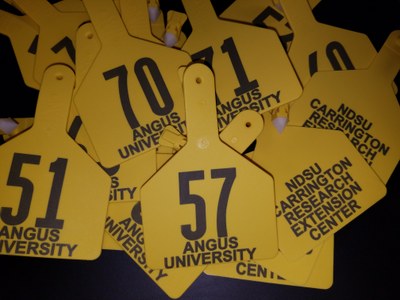
North Dakota Angus University tags ready for the 2019 program.
Participants in North Dakota Angus University will receive periodic progress reports on their calves' performance, as well as a final report on the overall performance, efficiency and carcass traits for their calves.
In 2018, calf performance was measured during a 97-day feeding study. Steers had an average daily gain of 4.36 pounds per day and a dry-matter feed conversion of 6.6 (pounds of feed to pound of gain).
This year's project, which is funded by the North Dakota Corn Utilization Council and North Dakota State Board of Agricultural Research and Education, will be a continuation of last year's research, evaluating the impacts of bunk management strategies with two inclusion rates of distillers grains in the diet to determine if the responses observed are similar with greater concentrations of dietary sulfur.
To consign a group of cattle or for more information. contact Bryan Neville, CREC animal scientist, at 701-652-2951 or bryan.neville@ndsu.edu; Karl Hoppe, Extension livestock systems specialist at the CREC, at 701‐652‐2951 or karl.hoppe@ndsu.edu; or Mike Wendel, North Dakota Angus Association program liaison, at 701‐710‐0425.
2018 Financial Analysis for South Central North Dakota
The North Dakota Farm and Ranch Business Management Education Program published their 2018 Annual Report for South Central North Dakota in mid-April. The report is a summation of the financial analysis for the 2018 fiscal year of the farms/ranches enrolled in the ND Farm and Ranch Business Management Programs in the region. The South Central Region consists of 20 counties in south central/eastern North Dakota, excluding the Red River Valley.
Exploring a few key numbers from the report, we see that average net farm income in 2018 was $127,089 compared to $116,714 in 2017. Net farm income ranged from $-23,274 (low 20% farms) to $379,822 (high 20% farms). The $127,089 net farm income compares with a low of $20,193 in 2015 and a high of $421,735 in 2012, when making comparisons over the last 10 years.
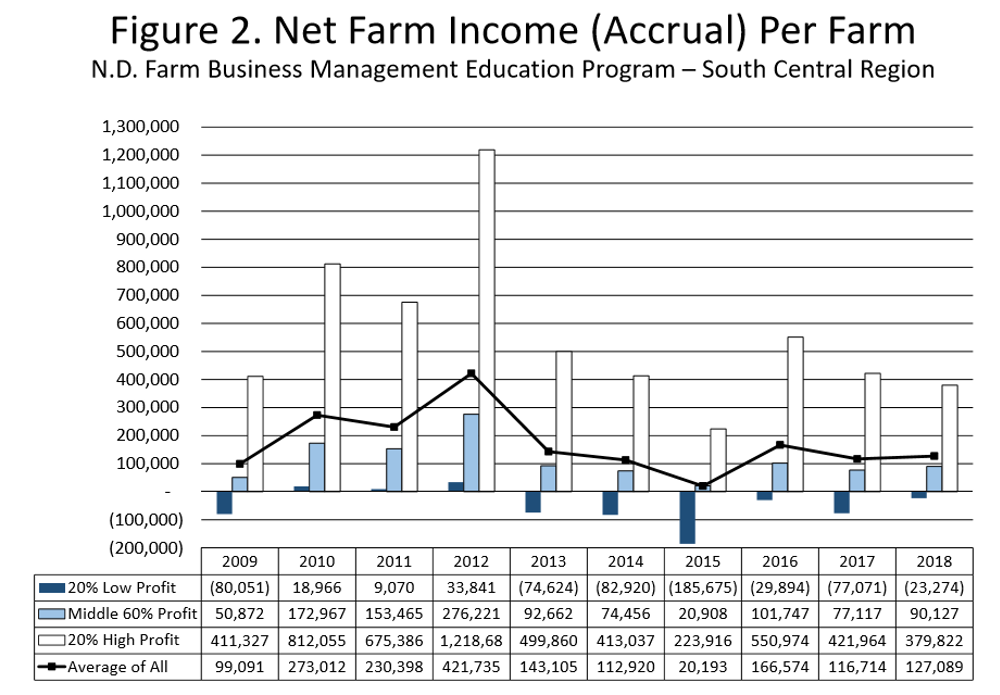
Gross cash farm income on the average farm was $878,646. Ranging from $662,236 (low 20% farms) to $1,803,585 (high 20% farms).
The average net worth of the farms/ranches in the region was $1,306,389. This represented an increase in net worth of $76,241 (6%) from 2017.
The average net return per acre on cash rented land before government payments/after government payments.
- Corn: $-1.68/$10.74
- Soybean: $70.58 (including MFP)/$87.94
- HRSW: $22.12/$40.30
- Barley: $13.35/$33.93
- Canola: $-32.75/$-15.49
- Pinto bean: $-6.32/$4.51
Beef cow-calf whole herd operations with backgrounding saw on average per cow $875.30 in gross revenue, $669.73 in total direct expenses, and $86.78 in total overhead expenses for a net return of $118.78 per cow.
Key financial ratios for the average farm in the region were:
- Current Ratio: 1.46 (working capital of $194,163)
- Farm Debt-To-Asset Ratio: 48%
- Farm Equity-To-Asset Ratio: 52%
- Rate of Return on Farm Assets: 4.7%
- Rate of Return on Farm Equity: 4.9%
- Operating Expense Ratio: 73.2%
- Interest Expense Ratio: 5.4%.
For additional information about the ND Farm Management Education program and to find more reports go to www.ndfarmmanagement.com.
Joel Lemer
Joel.Lemer@lrsc.edu
Farm Management Education Instructor
Retraining Grapes after Winter Injury
With the low temperatures North Dakota experienced this winter, I expect to see some damage to the more tender grape cultivars in our vineyard. If your plant doesn’t show new growth by July, it’s probably dead. But if you have a plant that has grown good for many years, and it appears dead or injured this spring, there is a good chance that it will come back from buds below the soil. Following are a few key things to look for pertaining to winter damage and some steps to help the plant recover.
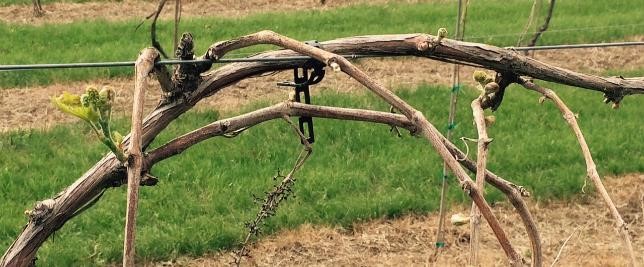
Assess the plant in early to mid-May. If there are some normal shoots (above, left) PLUS some small buds just opening or nodes with no buds opening, there is winter damage to the vascular system of the plant.

If you leave the plant as is, this is what will probably happen: a. The buds start to grow and then die (above, brown shoots on left side) and b. Vigorous new shoots will grow from the base. (What appears to be green leaves on the top of this plant are actually from the plant in the next row.)
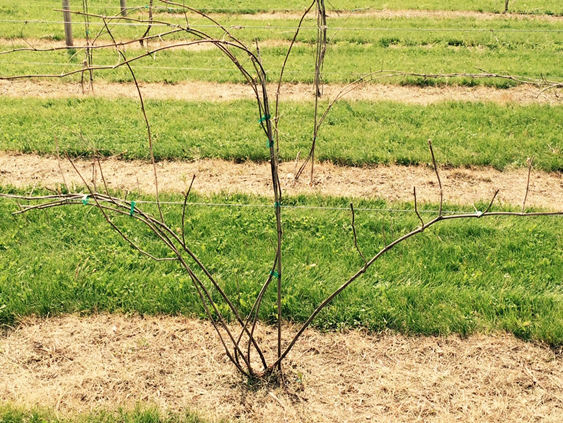
Cut the old plant down at the ground and remove everything old. Start training 4-6 fresh new shoots up into a fan shape over the summer. This picture shows how your new green, growing shoots should be positioned to give the plant some air. Use twine to loosely tie the canes to the wires. Train the BEST shoots upward to become possible new trunks. BEST= medium, moderately growing shoots. (Not the smallest and not the biggest.)
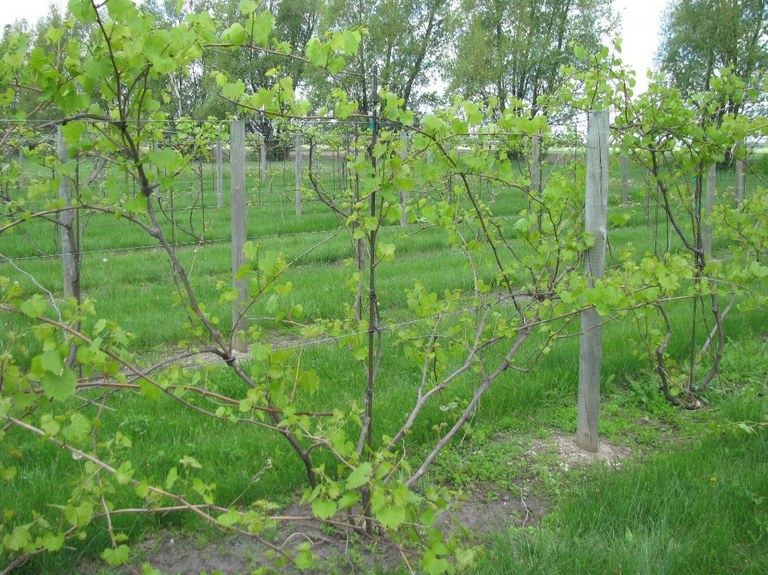
It is going to look like a mess! Check the plants twice a week to tie up the rapidly-growing shoots.
The next spring keep one good, medium cane as the new trunk. Cut it off just below the top wire and allow lateral shoots to become the new cordons. Also keep 1-3 canes of last year’s shoots on the lower wire so that they can fruit and use up some root energy.
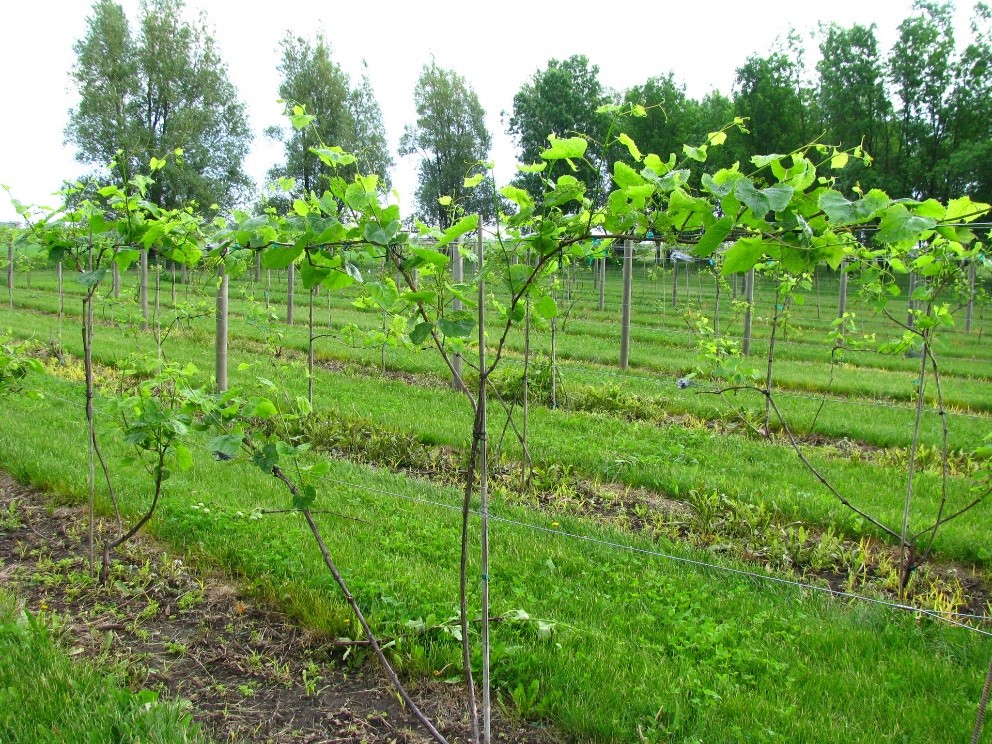
The following year (third spring), the new main plant with its new trunk and cordons, should fruit. When you are pruning this new plant, remove the 2 extra canes on the lower wire. (If you still think it’s super-vigorous, you can keep an extra cane, as in this picture above.)
Use your judgement as you go along in this process. After the injury, very vigorous plants need more shoots kept and spread over the trellis to spread out the root energy. If the regrowth is weak, only keep 1-3 new shoots and train them as above. Do NOT fertilize grapes in this stage. Slower growth is better.
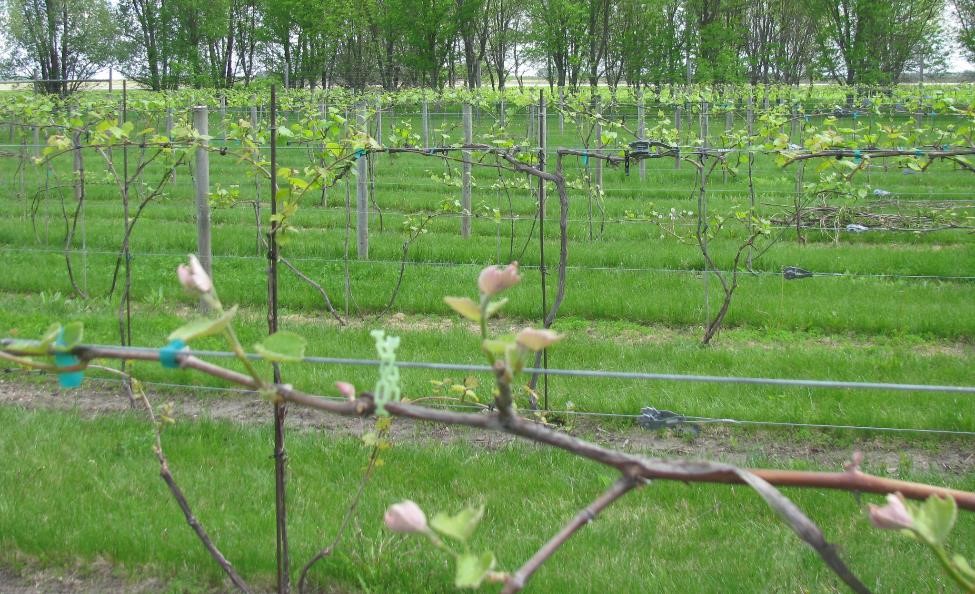 Good luck!
Good luck!
Kathy Wiederholt
Kathy.Wiederholt@ndsu.edu
Fruit Project Manager
Earth Day
Today, April 22, marks the 49th Anniversary of Earth Day. More than 1 billion people in 192 countries now take part in what is the largest civic-focused day of action in the world.
The first event, started as a political movement in 1970, motivated 20 million Americans from coast to coast to demonstrate for an end to environmental pollution. Public awareness resulted in the passage of the Clean Air Act, the Clean Water Act and the Endangered Species Act.
Each person can contribute to the cause by doing small things. Collectively, these efforts will make a positive, tangible impact.
- Organize a cleanup day. While we anxiously await spring, the melting snow reveals littered ditches and city parks. Great project for a youth group or fraternal organization, and a chance to enjoy the sun while getting some exercise.
- Reduce plastic consumption. Two easy ways: do your shopping with a reusable tote and trade plastic water bottles for a refillable bottle. Install an under-the-sink filter or a water filter pitcher, and save a bunch of money, too. Think about how many times you have doled out a couple of dollars for a single bottle of water.
- Finally, plant a tree. While tree planting has its own holiday in the name of Arbor Day, plant an extra tree for Earth Day. North Dakota is a prairie state, so where you find trees – especially in communities and rural shelterbelts – residents have planted the trees there. Globally, trees clean the air, stabilize soils and provide food. Across the North Dakota landscape, we appreciate trees for protection from wind, wildlife habitat, shade from the summer sun, and for beautification. Nature-health research reveals evidence that green spaces, even if just viewed from a window, help reduce measures of blood pressure, muscle tension, and heart rate.

Happy Earth Day.
Gerri Makay
gerri.makay@ndsu.edu
Community Forestry Program Manager
ND Forest Service
Is Club Root Becoming a Serious Soil Health Problem in North Dakota?
Club root is a soil-borne disease pathogen that infects roots of canola (Figure 1) and other crops of the brassica family (cabbage, collards, radish, turnip, etc.).
It is becoming a serious concern in canola producing areas, especially in northeast North Dakota.
Why is there concern?
Dr. V. Chapara at the NDSU Langdon Research Extension Center is leading disease scouting efforts of club root in several northeast counties. He has recently shown that there are more infected areas today than five years ago.
The disease is hard to manage because it produces spores that can live in the soil for as long as 20 years. Eradication of the disease-causing pathogens from an infected field is reported to be impossible.
It is not yet known how cover crop mixes that contain brassica seed like radishes and turnips will affect persistence of the disease pathogen.
How can you identify infected cropland?
- Scout fields regularly (plants are stunted, wilting, yellowing, premature ripening of pods)
- Aboveground part of diseased plants resembles nutrient deficient plants
- Uproot plants and observe for any root galls (Figure 1)
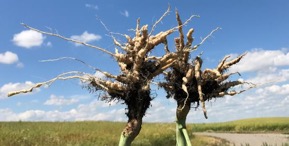
Figure 1. Club root of canola plant (Photo courtesy of Dr. Venkat Chapara).
How can you management it?
- Avoid planting canola in low pH soils, where club root has been identified
- Rotate canola with non-brassica crops, for at least five years
- Plant club root resistant varieties
- Prevent growth of weeds from the brassica family (e.g., wild mustard)
- Clean and disinfect field equipment and footwear after passing through an infected field
- Liming to raise soil pH to above neutral (> pH 7) though this warrants more research
NOTE: Suspected fields can be soil sampled and sent to a commercial lab for testing.
Jasper M Teboh, Ph. D.
Jasper.Teboh@ndsu.edu
Research Soil Scientist
Cover Crop Selection: Agronomic characteristics of selected plant families and species
Now, while we are impatiently waiting for spring to arrive, is a good time to be planning for use of late-summer or early fall planted cover crops in 2019. Remember, as a starting point, determine what your goals are with use of cover crops (e.g. reduce soil erosion; long-term increase in soil health; weed suppression; soil water management).
The following is a review of agronomic characteristics of plant species that you may consider using on your farm as a cover crop, with emphasis on use with cash crops. The information includes general characteristics of three plant families, and additional details on two selected cover crops within each family.
Grass family
Med-high carbon: nitrogen (C:N) ratio (higher amount of C to N increases resistance to residue break-down, e.g. corn > radish); high biomass (soil cover); soil builders (long-term potential increase in soil organic matter); nitrogen (N) scavenger; and arbuscular mycorrhizal fungi (AMF) association (increases ability of plant roots to obtain soil moisture and nutrients).
- Rye (winter; cereal)
- cool-season winter annual
- very winter hardy; weed suppression (allelopathy); fair soil salinity tolerance; high water use; reduce soybean cyst nematode (SCN) population
- do not follow with corn or cereal cash crops
- Millet
- numerous grain and forage types; warm-season annual
- shallow root system; low water use; short growth period
- poor tolerance to salty soils; requires mid-summer planting
Legume family
Low C:N ratio; symbiotic N fixation; AMF association, poor salt soil tolerance
- Field pea
- cool-season annual broadleaf
- shallow rooted; low water use; SCN host
- Fababean
- cool-season annual broadleaf
- cold tolerant; high N fixer; SCN non-host; dark residue after termination
- large seed size; poor drought tolerance
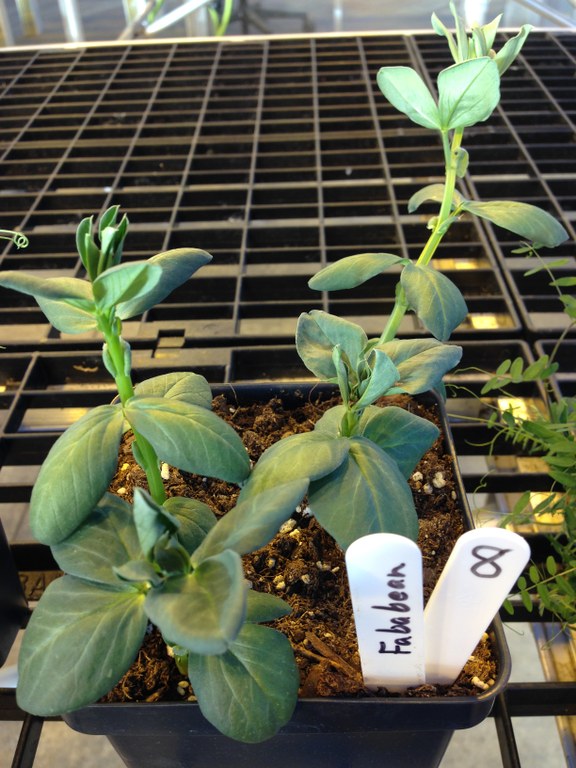
Fababean
Mustard family
Low C:N ratio; N scavenger; no SCN reproduction; poor salt soil tolerance; no AMF association
- Mustard
- numerous market (cash) and cover crop types; cool-season annual broadleaf
- med C:N ratio; low water use; potential biotoxin production (soil pest suppression)
- Radish
- cool-season annual broadleaf; root crop
- deep rooted (reduce soil compaction); reduce SCN; high water use
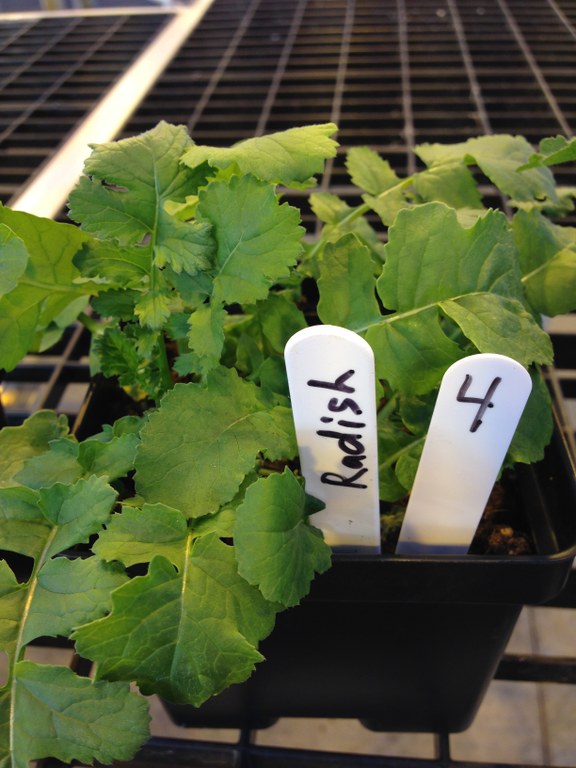
Radish
Contact NDSU Extension for more details including information on cover crop mixtures. Suggested references:
- Cover crop chart (USDA Agricultural Research Service)
- Cover crop common species and properties in SD (USDA)
- Starting with cover crops in ND (MCCC-1020)
- Incorporating cover crops (NDSU Extension)
Thank you for Spring, Calving, and all the Help!
This week’s Center Points is truly about appreciation. Partly for appreciation for spring which arrived this last week! But also appreciation for those that work at the CREC livestock unit.
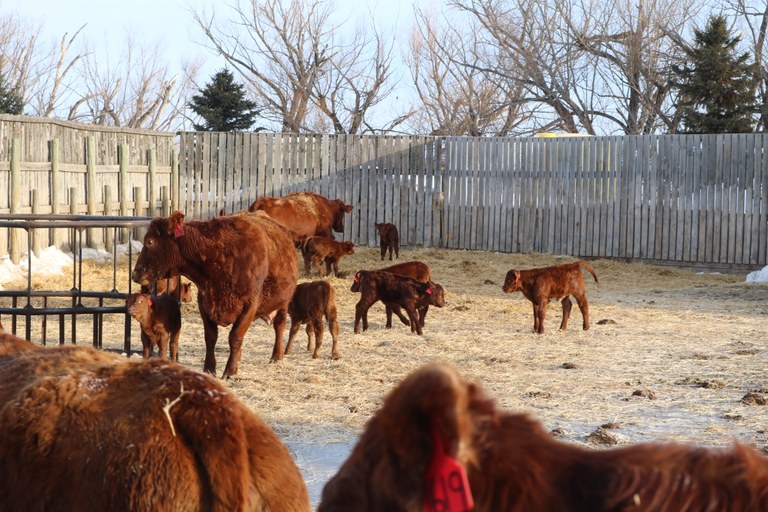 Calves enjoying the Spring sunshine!
Calves enjoying the Spring sunshine!
I want to highlight some of the upcoming activities at the Livestock Unit and express my appreciation to the staff (Jesse Nelson, Kalie Anderson, and Tim Schroeder) for their efforts. We are in the midst of calving and by the time you read this we will be nearly 85% done.
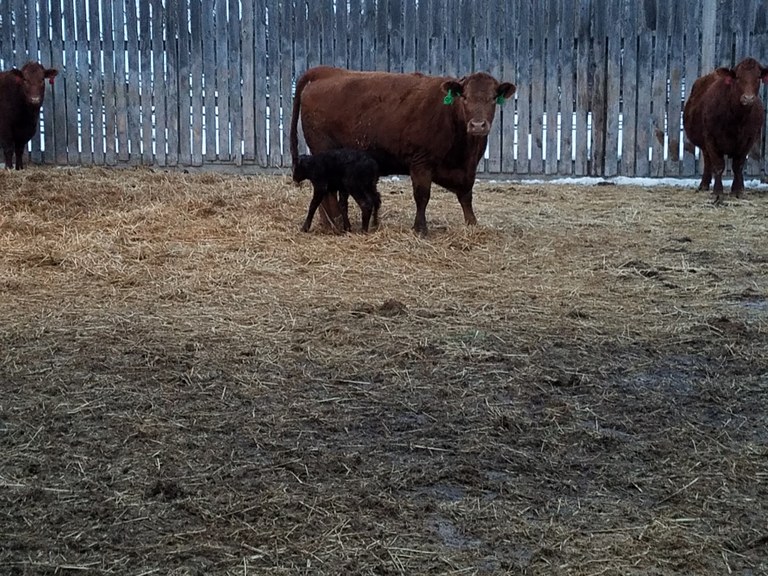
A new calf at the CREC, just a few minutes old.
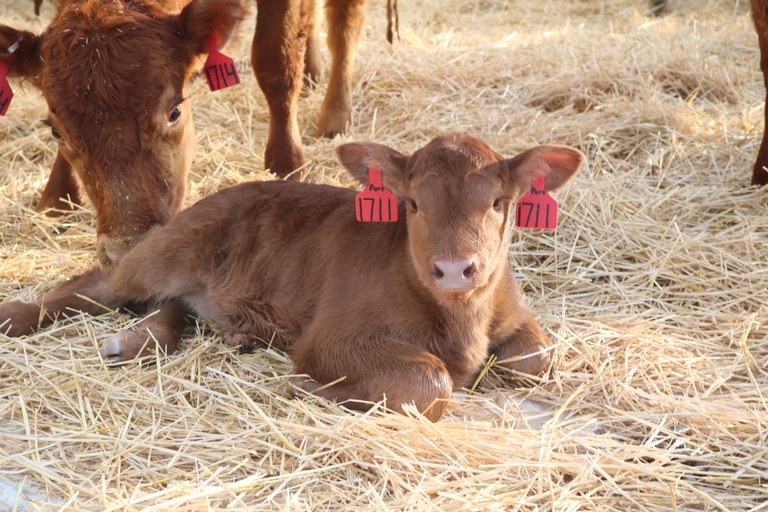 An older calf enjoying the morning sunshine.
An older calf enjoying the morning sunshine.
There are also a number of research projects that all of us at the CREC livestock unit will be beginning shortly. This includes work that is funded by the North Dakota Corn Utilization Council and the North Dakota Soybean Council. We are also collaborating with a number of universities around the country on a project evaluating artificial insemination practices.
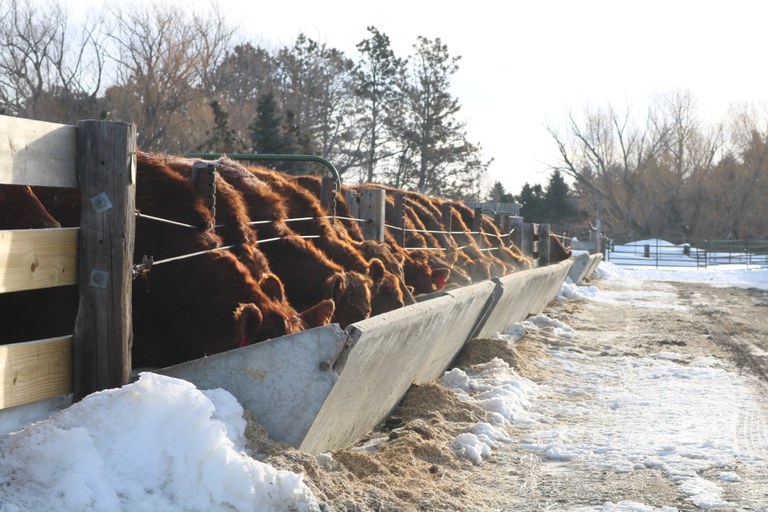 The cows at the CREC filling their bellies on a sunny morning.
The cows at the CREC filling their bellies on a sunny morning.
Caring for livestock isn’t an 8-5 job, and being in livestock research sometimes makes it a bit more challenging. Thanks, Livestock Unit crew, for all your hard work and effort.
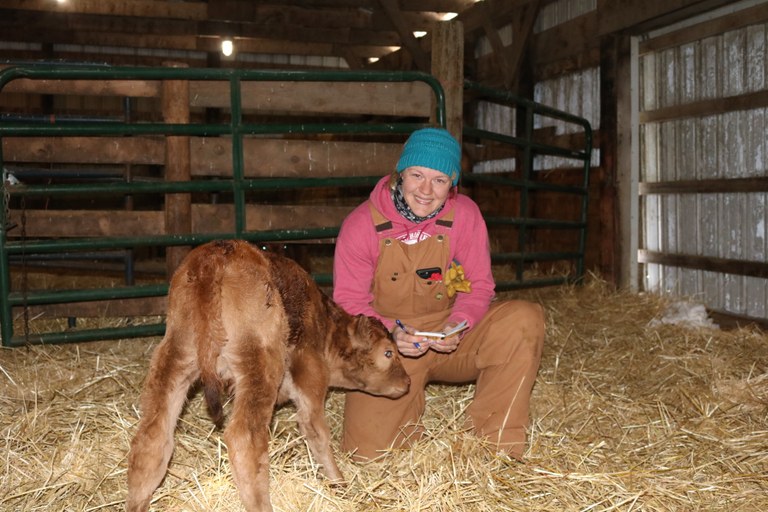
Kalie Anderson
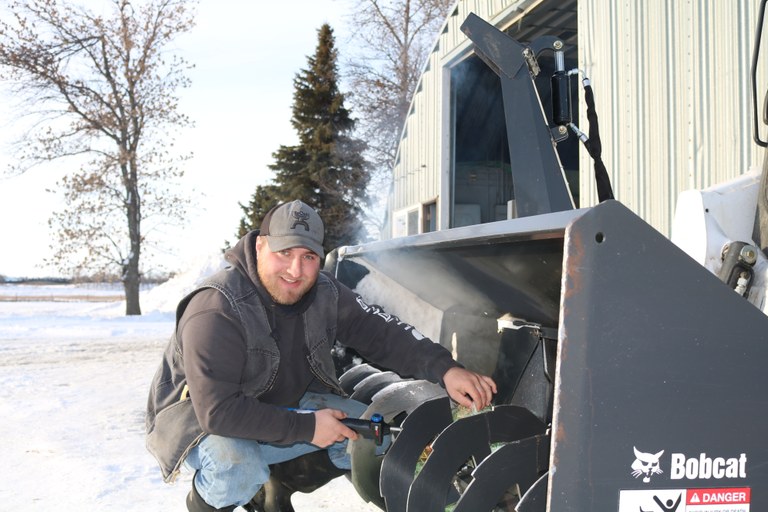
Jesse Nelson

Tim Schroeder
Bryan Neville, Ph. D.
Bryan.Neville@ndsu.edu
Animal Scientist


